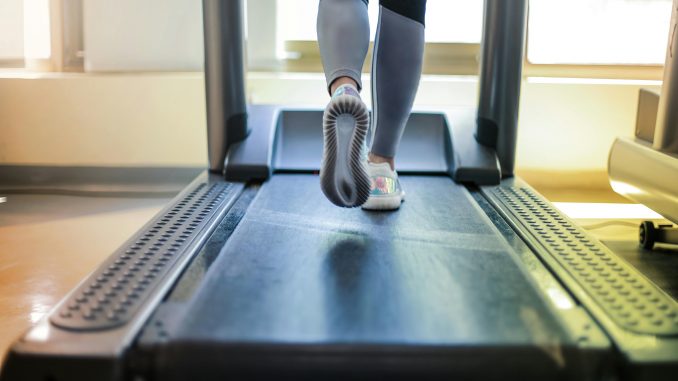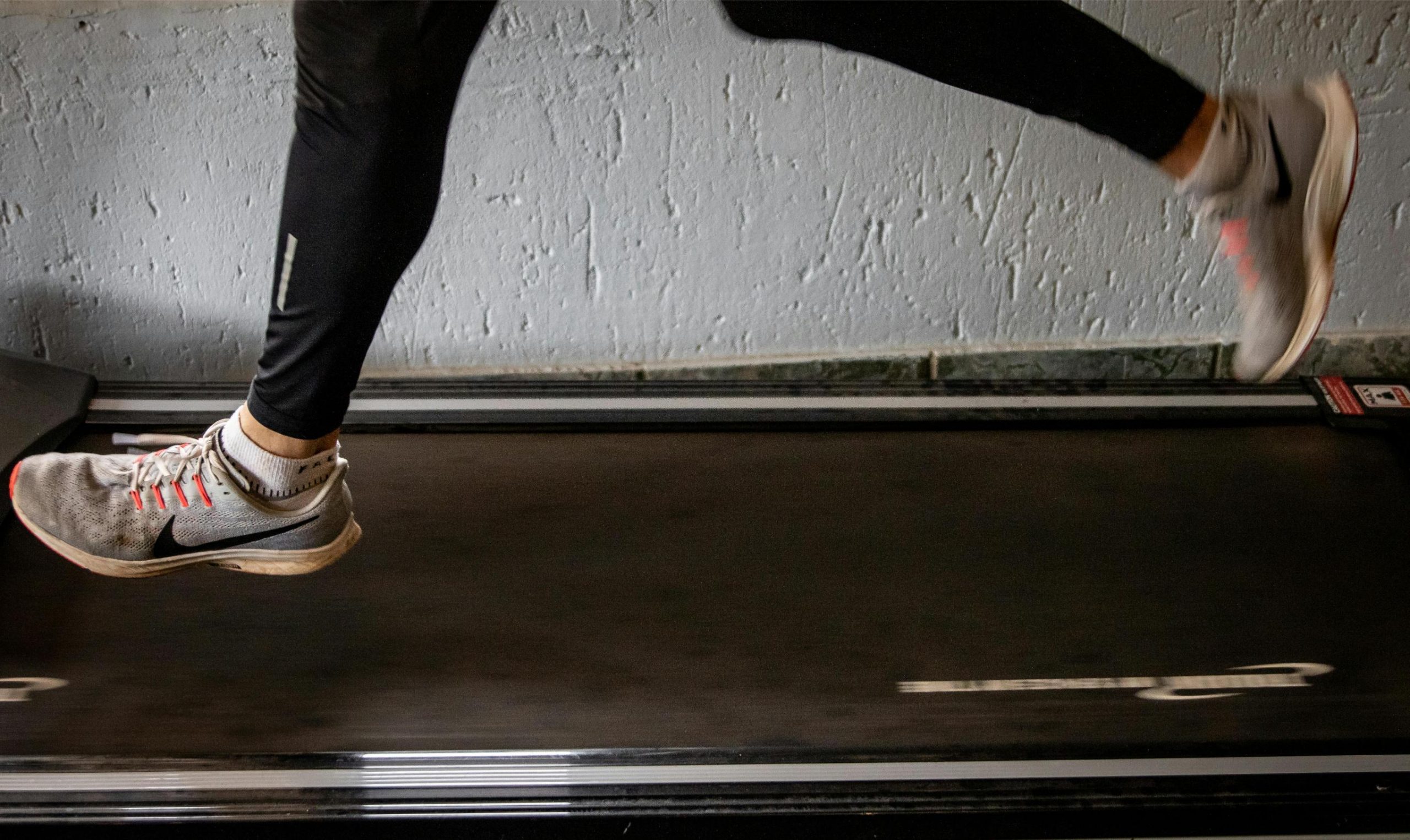

A walking pad is a compact, low-speed treadmill designed mainly for walking. Most walking pads are slim and can slide under a standing desk or be stored under a couch. They are ideal for those who want to stay active while working from home or living in smaller spaces.
Pros of Walking Pads
- Ultra-compact and easy to store
- Quiet operation, ideal for shared spaces
- Encourages light daily movement
- Great for home offices or apartments
Cons of Walking Pads
- Limited speed; not suitable for running
- No incline or advanced workout options
- Typically lacks handrails
- Lower weight capacity
Benefits of Using a Walking Pad

Encourages Daily Movement
Walking pads make it easy to stay active throughout the day, especially if you spend a lot of time at a desk or indoors. You can walk while checking emails, attending virtual meetings, or even watching your favorite shows. This steady, low-effort movement adds up over time and can improve overall health, help with weight management, and boost your energy.
Low-Impact Exercise
Unlike running, which puts stress on your knees, ankles, and hips, walking is gentle on the joints. Walking pads offer a smooth, low-impact workout that’s ideal for people with arthritis, joint pain, or those recovering from injury. They provide a safe, consistent way to keep moving without the risk of overexertion.
Space-Saving Design
One of the biggest advantages of a walking pad is its compact size. Many models are slim enough to fit under a standing desk, couch, or bed. Some even fold in half, making storage a breeze in small apartments or tight spaces. If you don’t have room for a full-size treadmill, a walking pad offers a smart, space-efficient alternative.
Quiet Operation
Most walking pads run quietly, making them perfect for shared living spaces or home offices. You can walk while on calls or during focused work hours without disturbing others.
Ease of Use
With simple controls and low-maintenance design, walking pads are beginner-friendly. There’s no need for complex setup or fitness knowledge—just turn it on and start walking.
Cost Comparison with Other Fitness Equipment
Walking pads are generally cheaper than full-sized treadmills or stationary bikes. Basic models start around $200–$300, while high-end versions may go up to $600. Compared to traditional treadmills, which can cost $800–$2,000, walking pads offer good value if your main goal is light walking.
Ideal Users for Walking Pads
Work-from-Home Professionals
Remote workers often sit for long periods, which can lead to stiffness, weight gain, and poor posture. A walking pad allows you to move while attending virtual meetings or answering emails. Walking while working can also help boost creativity, improve mood, and enhance focus throughout the day. It’s a great way to stay productive without sacrificing your health.
Seniors and Beginners
Walking pads are gentle on the joints, making them ideal for older adults or anyone starting a new fitness routine. There are no complicated buttons or steep learning curves—just step on and start walking. Because they operate at lower speeds and don’t require intense physical effort, they provide a safe, consistent way to maintain movement and improve cardiovascular health.
People in Small Homes or Apartments
If you live in a studio, apartment, or shared home, space is often limited. Walking pads are slim, lightweight, and easy to store. Many models can fold or slide under beds, couches, or desks. This makes them perfect for people who want the benefits of indoor walking without the bulk of a treadmill or full-sized gym equipment.
Are They Effective for Weight Loss?
Walking pads can definitely help with weight loss, especially when used regularly and paired with healthy eating habits. They promote steady, low-impact movement that burns calories over time. For example, a person who weighs about 150 pounds can burn roughly 100 calories by walking at 2 miles per hour for 30 minutes. That might not seem like a lot, but when done daily, those calories can add up and support a calorie deficit—the key to losing weight.
Consistency matters more than intensity when it comes to using a walking pad. Unlike high-intensity workouts that burn a large number of calories in a short time, walking pads encourage you to stay active throughout the day. You can walk while watching TV, answering emails, or attending online classes. This kind of steady movement helps boost your metabolism and makes it easier to reach your fitness goals.
While a walking pad may not replace intense cardio sessions for quick fat loss, it can absolutely be part of a successful weight loss routine. Over time, using it daily—even for short sessions—can lead to meaningful results. Plus, because it’s gentle on your joints, it’s easier to stick with long-term.
Maintenance and Durability
Walking pads are known for being easy to maintain, especially when compared to larger gym equipment. However, like any machine with moving parts, they still need some basic care to keep them running smoothly.
Here are a few simple maintenance tips:
- Keep the belt clean: Dust, pet hair, and debris can build up under the belt. Wipe it down regularly to prevent damage.
- Lubricate every few months: To keep the belt moving smoothly and avoid friction, apply treadmill belt lubricant about every 2–3 months, or as recommended by the manufacturer.
- Check the alignment: If the belt starts drifting to one side, it may wear unevenly. Make sure it stays centered by adjusting the alignment screws.
In terms of durability, most walking pads last between 3 to 5 years with regular use. If you’re using it daily and taking care of it, you can expect it to hold up well. Higher-end models, which often come with stronger motors and better materials, may last even longer—especially with consistent upkeep.
Taking just a few minutes to clean and check your walking pad each week can help extend its life and ensure safe, smooth workouts.
Safety Tips for Using a Walking Pad

Walking pads are generally safe and easy to use, but following a few key safety tips can help prevent accidents and make your experience more comfortable.
- Use on a flat, stable surface: Always place your walking pad on an even floor to keep it steady during use. Avoid using it on rugs or uneven surfaces that might shift or cause imbalance.
- Keep your eyes forward: Looking down at your phone or computer for too long can throw off your balance. Try to keep your head up and eyes forward as much as possible, especially when adjusting your pace.
- Start slow and increase your pace gradually: Begin each session at a low speed to get used to the movement. Once you feel comfortable, slowly increase the speed to a level that feels natural and safe.
- Wear proper walking shoes with grip: Skip the slippers or socks. Instead, wear sneakers or athletic shoes that have good grip and support to reduce the risk of slipping or hurting your feet.
Taking these steps can help you stay safe while getting the most out of your walking pad workouts.
Buying Tips: What to Look For
Choosing the right walking pad depends on your needs and lifestyle. Here are a few important things to keep in mind before you buy:
- Weight Limit: Always check the maximum weight a walking pad can support. Most models handle around 220 to 250 pounds, but some heavy-duty options are built for more. Going over the limit can cause faster wear or damage.
- Speed Range: Basic walking pads usually top out at 3 to 4 mph, which is fine for casual use. If you want a brisker pace or plan to use it for light jogging, look for models with higher speed settings.
- Noise Level: Planning to walk during video calls or in a shared home? A quieter motor—ideally below 60 decibels—will help you stay active without disturbing others.
- Portability: If you need to store it after use, choose a lightweight model with wheels or a foldable frame. Many walking pads are slim enough to slide under a bed or stand in a closet.
- Warranty: Look for at least a 1-year warranty. Better-quality models often offer up to 3 years of coverage for the motor or frame, giving you extra peace of mind.
These tips can help you pick a walking pad that fits your space, goals, and budget.
Final Verdict: Are Walking Pads Worth It?
If your goal is to stay active without leaving your home or disrupting your workday, then yes—walking pads are worth it. They help reduce sitting time, support low-impact movement, and fit in small spaces.
They may not replace a treadmill or gym, but for light use and convenience, they’re an excellent option. Think about your budget, goals, and lifestyle before making a purchase.
And if you’re still deciding, compare your needs in detail by researching more on walking pad vs treadmill options to make an informed choice.